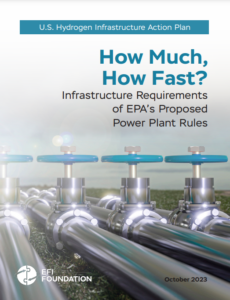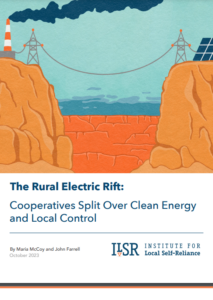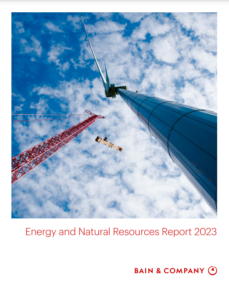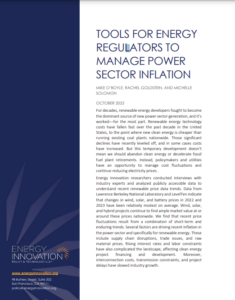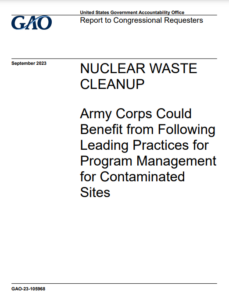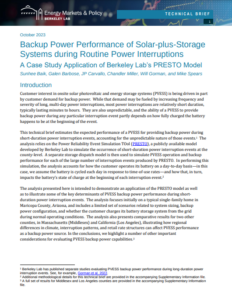The OurEnergyLibrary aggregates and indexes publicly available fact sheets, journal articles, reports, studies, and other publications on U.S. energy topics. It is updated every week to include the most recent energy resources from academia, government, industry, non-profits, think tanks, and trade associations. Suggest a resource by emailing us at info@ourenergypolicy.org.
Resource Library
This report focuses on the infrastructure needs of the U.S. Environmental Protection Agency’s (EPA’s) proposed rules for fossil-fueled power plant emissions reductions. This modeling-driven study analyzes the potential outcomes of EPA’s proposal on the energy system by region, including the costs of the potential electricity, hydrogen, and carbon dioxide (CO2) infrastructure requirements.
The report is the first in a new report series called the U.S. Hydrogen Infrastructure Action Plan, which analyzes the opportunities of hydrogen infrastructure for enabling market formation. This series is a follow-up to the February 2023 Energy Futures Initiative (EFI) report, The U.S. Hydrogen Demand Action Plan, …
View Full ResourceThis paper examines the struggle of electric distribution cooperatives and their members to restore local control over electricity purchasing and harness the benefits of affordable clean energy. It covers the misalignment, contract breaks, and contract re-negotiations between distribution cooperatives and the generation and transmission cooperatives that serve them.…
View Full ResourceTransportation plays a crucial role before, during and after an emergency. Transportation agencies’ unique role stems from their broad range of capabilities and responsibilities.
NCHRP Web-Only Document 384: Developing an Emergency Management Playbook for State Transportation Agencies, from TRB’s National Cooperative Highway Research Program, helps develop a playbook to support emergency management program review and development for state transportation agencies.…
View Full ResourceThe assessment of climatic and extreme weather risks is increasingly becoming important to the operation of transportation agencies. There are easy-to-use tools and techniques that can be implemented by agencies.
NCHRP Research Report 1066: Risk Assessment Techniques for Transportation Asset Management: Conduct of Research, from TRB’s National Cooperative Highway Research Program, discusses how to assess risks and summarizes 12 studies that demonstrate how to enhance the measurement of risks, quantify risks, and better link risk management processes with the appropriate tools.…
View Full ResourceExecutives in the fields of oil and gas, utilities, chemicals, mining, and agribusiness are on the frontlines of the energy and natural resource (ENR) transition. While concerns about climate change and extreme weather grow, and customers and shareholders call out for rapid decarbonization, these executives are tasked with changing the way the world produces and uses energy, food, and many critical materials—all while keeping their businesses viable.
Findings from this report come from discussions with clients and a survey in early 2023 of more than 600 executives across the energy and natural resource sector.…
View Full ResourceClean energy costs have fallen so fast over the past decade that they’re now the cheapest sources of new electricity generation. But that trend has reversed and clean energy costs have modestly risen– is it a blip or a sign of things to come? New Energy Innovation research shows the factors driving clean energy cost increases are mostly cyclical and temporary. Governments can restore falling renewable costs and save consumers money by reforming the interconnection process, investing in domestic supply chains, improving transmission planning, and making state and federal commitments to diversifying clean energy, among other options. Policymakers shouldn’t hit …
View Full ResourceOffshore wind (OSW) power based on floating technology in the coastal waters of the U.S. Pacific Ocean has great potential to contribute to climate mitigation and renewable energy goals in California, Oregon, and other parts of the western U.S. To achieve development of OSW at scale, investments in transmission infrastructure are needed to deliver this power to major metropolitan areas because these are the primary electricity load centers. Currently the transmission infrastructure serving coastal regions where OSW is most likely to be developed has limited capacity and is designed to bring power from the east to serve modest coastal loads. …
View Full ResourceAtomic energy activities supported by the federal government generated large amounts of radioactive and hazardous waste over several decades of nuclear weapons production and energy research following World War II. This waste has contaminated soil, groundwater, and structures at sites across the country, posing potential risks to human health and the environment.
The Corps is responsible for cleaning up or controlling contamination at some of these sites through FUSRAP. GAO was asked to provide information about the Corps’ efforts to clean up contamination under FUSRAP. This report, among other things, (1) describes the reported environmental liabilities associated with active FUSRAP …
View Full ResourceCustomer interest in onsite solar photovoltaic and energy storage systems (PVESS) is being driven in part by customer demand for backup power. While that demand may be fueled by increasing frequency and severity of long, multi-day power interruptions, most power interruptions are relatively short duration, typically lasting minutes to hours. They are also unpredictable, and the ability of a PVESS to provide backup power during any particular interruption event partly depends on how fully charged the battery happens to be at the beginning of the event.
This technical brief estimates the expected performance of a PVESS for providing backup power …
View Full ResourceEnabling procurement and promoting a market for low-carbon industrial materials is an important demand-side measure to accelerate the decarbonization of heavy industry. The green premium of low-carbon industrial materials can be shared along the value chain, and a robust demand-side market can reduce transition costs through economies of scale.
In this report, the authors first summarize Chinese and global practices in public and private low-carbon procurement, and then propose a framework of key elements for low-carbon procurement: (1) scope definition; (2) a carbon accounting and certification system; (3) carbon criteria for products, services, and/or suppliers; (4) incentives for low-carbon products …
View Full Resource